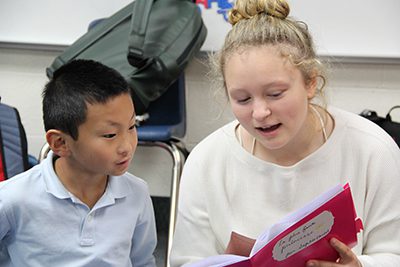October 29, 2018
 This article is the third in a series called “The Fall Campaign Stories of Impact: Five Weeks, Five Stories, Five Reasons to Give.”
This article is the third in a series called “The Fall Campaign Stories of Impact: Five Weeks, Five Stories, Five Reasons to Give.”
Bilingualism is one of the best things you can do for your brain. Research shows that young children who learn a second language have improved cognitive abilities, attention control, and problem solving skills. As they progress though school, continued language study correlates with academic achievement, higher ACT and SAT scores, and better performance at the college level. And as we age, fluency in more than one language has been connected to faster stroke recovery and delayed onset of dementia.
While the benefits are powerful, only 20 percent of K-12 students in the U.S. are enrolled in world language courses. At MPA, we take global awareness and the study of other languages seriously, and embed world language in our curriculum from the first days of Kindergarten through 12th grade.
“Our students have world language classes eight to nine days out of a two week cycle, compared to other schools that might offer a language class once or twice a week,” explains Lower School French teacher Liz DesLauriers. “Because we see students so much more regularly, we can cover a greater breadth of material. And, since our faculty is made up of native and near-native speakers, students are learning the sounds and dynamics from teachers who are fully fluent, which helps students achieve excellent pronunciation and also interpret the body language and cultural cues tied to the language.”
Upper School Spanish teacher Kari Kunze agrees. “When you learn a second language with the competence and depth that MPA students do, you gain so much more than the technical aspects.” In addition to immersing students in the language, teachers quickly introduce the surrounding culture, history and current events. “When you know a language well and understand the culture, you are more equipped to appreciate the art, poetry, and music of a country,” says Kunze.
MPA’s world language courses build fluency and cultural understanding while fully embracing the fun. “One of my driving forces is, how can we find joy in the curriculum?” says DesLauriers. “Food, music, stories, plays, trips to the Makerspace–they’re also an important part of learning another language, and to opening doors to being good global citizens.”
Because of philanthropy at MPA, foreign language instruction is having a life-time impact on our students’ brains. Consider making a donation to the MPA Fund during the Fall Campaign by visiting moundsparkacademy.org/donate or contacting Susan Robertson, Annual Giving & Alumni Relations Manager, at 651-748-5531. Together, we will raise $300,000 to bridge the gap between tuition and the total cost of educating a student at MPA.
Sources:
“What the Research Shows.” American Council on the Teaching of Foreign Languages, accessed 26 Oct. 2018, https://www.actfl.org/advocacy/what-the-research-shows.
Vince, Gaia. “Why being bilingual works wonders for your brain.” The Guardian, 7 Aug. 2016, https://www.theguardian.com/science/2016/aug/07/being-bilingual-good-for-brain-mental-health.
Devlin, Kat. “Unlike in US, Most European Students Learn a Foreign Language.” Pew Research Center, 6 Aug. 2018, www.pewresearch.org/fact-tank/2018/08/06/most-european-students-are-learning-a-foreign-language-in-school-while-americans-lag/.